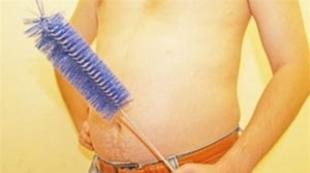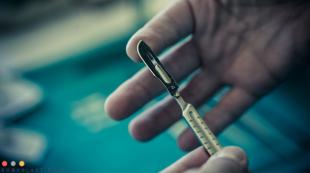Pliers for cleaning insulation. Handy tools for quick wire stripping
There are various wires and cables, some are laid according to the standard scheme, the second - through the air. It is the first ones that have a special protective layer, which allows you to exclude the closure. Such a surface is subjected to dismantling in the process of performing the most simple tasks. For example, this is a connection of two cables so that the contact point becomes as tight as possible and works efficiently.
The question arises: "How to remove the insulation from the wires?". To facilitate this process, there are many different techniques and techniques. Because it is not always necessary to completely disassemble the cable, sometimes you just need to strip the contacts and not damage the main core.
In order not to be mistaken and to understand exactly how to remove the insulation from the wire, it is worth arming yourself with the instructions and taking the correct recommendations as a basis. But without the proper tool, the work will not be done. In addition, wires and cables can have a different basis, the methods differ accordingly.
Features of stripping insulation and problems in the performance of work
Before removing the insulation from the wires, it is worth considering some of the nuances of the process. After all, the coating can be in one layer and several. The work is done quickly, but this will require the use of a stripper.
If you do not delve into the details, many do not see the difficulties in the procedure for cleaning a cable or wire from protection. But without sharp, cutting objects, the work will not go smoothly. As a result, there is a possibility of violating the integrity of the wire itself. The following may happen:
- The formation of holes in an unnecessary place.
- There is a possibility of injury.
- Damage to the conductor itself.
All this is easy to exclude if a simple and accurate instruction for implementation is taken into service. In addition, special tools are required. Do not rush, even if you have experience in completing the task. It is worth at least theoretically understanding how to remove insulation from wires with a tool.
What kind of wires are there?
There are two main cores used in the process - copper and aluminum. If you remove the insulation, then with each view you will have to be careful and take your time. In terms of strength, copper retains its integrity longer than aluminum. Below we consider the properties and characteristics of each.
Aluminum:
- Density is expressed in t/m 3 . More than 2.6.
- There is no resistance to frequent bending.
- It will not work to create a multi-wire core.
- The specific resistance is insignificant.
- Density is expressed in t/m 3 . More than 8.8.
- Resistance to frequent bending is present.
- It will be possible to create a multi-wire core.
- Resistivity is good.
From these data, we can conclude that the copper wire is better and its current conductivity is higher. But aluminum is not reliable. high level, so it is used less frequently. Great care must be taken during the cleaning process. Therefore, before removing the insulation from the copper wire, it is worth making a small notch and preparing the appropriate tool. There are not so many options for working with cables and wires, it is important to choose not just a suitable method, but an effective one.

What methods are effective?
Most of the skill in removing the protective layer from a cable or wire comes with time and practice. Especially when you need to do cleaning on the thinnest possible wire.
The main thing is to correctly choose the degree of application of effort and pressure on the tool. In addition, the speed of work and the final result depend on the direction of movement. You have to understand how deep the main vein is. It will depend on whether it is damaged or not. Before you remove the insulation from or copper, you will have to figure out what kind of material is inside.
The simplest options for doing the job:
- The use of a clerical or ordinary knife. If you chose the first option, then you should not take too large, they are inconvenient to work with. Pressing should not be maximum, since their blade is quite sharp. A simple knife should have a narrow blade and high-quality sharpening.
- Use of side cutters. This is a convenient design, it is similar to scissors, but stronger and sharper. They are sold in any hardware store, although many always have them on hand.
- Burning. This is another good option and less traumatic. For this you need to apply high temperature to melt the winding. If it is required to make a small release, then this method is ineffective, since a rather large area is burned.
- Using a stripper. This tool is chosen by professionals.
Knife application
How to quickly remove insulation from wires? This is the most common and effective method, but it is very traumatic. When you need to process a small amount of wires at home, then this option is quite suitable. The main thing that is tedious to know is at what angle to lead the tool. You can not make circular movements, because it is completely inefficient. Because with this option there is a high probability of incision of the main working core. After that, the wires will become unusable.

The angle of inclination is as sharp as possible so that it does not happen deep penetration blades into the body of the wire. Only slight slip is allowed. You should choose the “away from you” position - such conditions are safe for the worker and for the cable itself.
electrician's knife
An electrician's knife is the most convenient tool. It has a heel, so it is quite easy to hold it. At the same time, the core is protected as much as possible, the hands are safe, and the insulation is removed efficiently. This is the answer to the question: "How to quickly remove the insulation from a copper wire or aluminum?"
Side cutter - effective help
It is a metal tool with comfortable handles. But most often the work is done by the masters. In this process, you need to know what force to apply, otherwise damage to the main core may occur. Electricians know how to carry out the stripping process. Side cutter is used in several cases:
- When the cable is too thick, biting is done in several places along the entire length, and then the insulation is removed by hand. This option is quite suitable for inexperienced people. But the cuts must be made carefully so as not to violate the integrity of the main cable.
- It is necessary to draw a strip along the entire length, and then remove the main winding downwards.
- Through a distance of 3 centimeters, cuts are made with a side cutter. Then you need to remove the winding in small pieces.
These are the easiest options for people with no experience and not only. Masters easily work with this tool. This option will help to easily remove the insulation from the wire for scrapping. In order not to damage the main core, it is worth holding the sharpened jaws in the opposite direction of tightening and removing the insulation. This allows you not to break anything and get the job done quickly.
Today, there are wires on sale on which the manufacturer makes special notches during the creation process so that the insulation is quickly removed. Therefore, before removing the insulation from the copper wire, it is worth considering it: you may not even need tools.
Burning
This is the easiest way when you need to remove the insulation for the delivery of wires. It is also the most effective method if there are PVC cores inside. When you want to process a small area, then use a lighter or soldering iron. Under thermal influence, the winding softens, and it simply comes off the wire. With a small thickness of the winding, this option is the most effective.
There is one drawback - it is the presence of a smell. Therefore, it is necessary to carry out work in a room with access fresh air. Toxic secretions during the roasting process adversely affect the state of the body.
What is a stripper?
It is these tools that help to do the procedure quickly and efficiently. But not every cable is suitable for such work. The cross section must be at least 0.2 mm. On sale or from the masters can be found different kinds appliances:
- Manual stripper without add-ons. Its use is similar to working with a side cutter: notches are made, after which the winding is removed. But this option is not suitable for every section.
- Semi-automatic At the base there is an adjustment lever that regulates the degree of pressure, after which, when the handles are closed, the main process of stripping begins.
- Machine. This is the most the best way because it is based on several functions - notching, removing insulation, crimping cores.

As a result, this method brings many positive aspects. The main thing is that cuts of the main core are completely excluded. As a result, this method can be called the best. It is the stripper that allows you to properly remove the insulation from the wires without damaging the core.
Cable check
When work is underway to get rid of the winding, you need to carry out actions in a clear sequence. Each cable has its own characteristics. Work on the copper cable must be carried out in the following order, since it has two layers of PVC insulation:
- The power supply is turned off.
- During the installation of the outlet, you need to clean only a strictly defined area. 15 cm is enough. A person without experience should not reduce this distance. For this procedure, a side cutter is used.
- The upper part is cut and carefully removed.
- The required length is set on the stripper, after which the phase and neutral conductors are placed in the tool. A complete cleanup is done.
This is the whole scale of work, after which it is required to fix the outlet. It is not difficult to make such a procedure, although mistakes are often made. The wire breaks, and you have to strip further.
How not to crimp?
Experts believe that it is not so easy to remove insulation from cables and wires. As a result, many mistakes are made that lead to a bite of the main core. The main reason is the use of the wrong tool. Therefore, there is a special list of those violations that are worth knowing not only for beginners, but also for masters:
- When the top layer is removed and needs to be trimmed, often the master chooses the wrong angle, which leads to notches on the main core. Even a slight, imperceptible notch in the insulation of a conductive cable leads to a short circuit, and sometimes to a complete failure of the entire device.
- Incorrect use of side cutters. They have a sharp side and a blunt side, often choosing the wrong side. As a result, there is a sharp sliding along the wire, which leads to excessive tension and compression, and this is already a violation of the integrity of the main core.
- A knife with a heel is convenient, but it must be clearly directed, namely, to choose the angle of inclination. The mistake made leads to the fact that the main cable is cut. And the violation of secondary insulation brings more serious problems.

Everything happens because of the illiterate choice of the tool. But there are other problems: a frivolous attitude to the procedure for cleaning the winding of the main cable or wire. Before you remove the insulation from a thin wire, you should know what actions you have to perform, and do everything carefully and in a clear sequence. There are situations when the distance for work is minimal and it is unacceptable to take risks.
We repair headphones
A common problem when using headphones is a violation of the integrity of the wire. To restore it, you need to choose a simple clerical knife for work. The procedure takes place in several stages:
- You need to find a breakdown.
- Remove the top winding by making a neat longitudinal cut.
- Connect the components and insulate them.

How to remove wire insulation from headphones?
You can use a sheet of sandpaper. Its granularity does not matter (the main thing is to perform work on the front side of the element). We set the edge of the wire on sandpaper and press on top with a soldering iron. He will melt our winding. Further, its remains can be removed by hand. As a result, we get a wire without insulation. After that, you can make a connection using the same soldering iron. This is not a long procedure, but everyone can come to a positive result. No need to experiment, each tool does its job. When working with wires and cables, a sharp knife and a stripper are used; in other situations, it is worth choosing the appropriate devices.

Conclusion
So, we looked at how to properly remove the insulation from the wires. As you can see, there are different tools and methods. You just need to choose the most suitable one and follow the instructions.
In production and at home, questions often arise about how to strip the wire. Unfortunately, many craftsmen, doing this work, make a number of technical errors, which further worsens the operation of electrical systems.
Wire stripping is needed in a variety of cases:
- if necessary, connect the wires to increase the length of the conductor;
- when performing wiring inside a residential building or any other building;
- when connecting lighting devices;
- when connecting equipment using electrical devices (machines, stands, conveyors, tools and other equipment);
- when installing switches and sockets;
- when installing special control and regulation equipment in switchboards, etc.
Before proceeding with the stripping of wires, you need to know the features of their device and insulation. Then it will become clear what to do in each case.
Attention! All work on electricity and networks should be carried out only with the power turned off. Warning signs are posted at the disconnection points, prohibiting self-powering.
Features of the structure of electrical wires

Electric wires are made in two versions:
- single-core - have a single core enclosed in insulation;
- stranded are twisted conductors enclosed in a common insulation.
For single-core wires, the cross section is formed by only one core. - this is a characteristic in square millimeters, which is used when choosing depending on the magnitude of the current. In stranded wires, the cross-sectional area is given by the total set of all available cross-sections of the cores. For elasticity, a nylon thread is often added inside - this small addition improves the performance properties of the cable.

Insulation can be single or double. It is made from various insulating materials:
- plastics - polymeric materials based on organic compounds, thermoplastics are more often used - softening when heated. They can mix with each other, connecting into a single whole. These plastics support combustion by releasing various toxic gases;
- plastics that harden when heated are called thermosets. Of these, insulation is made only for special applications, when increased requirements are placed on it;
- different types of natural or artificial rubber (rubber), hardening when heated, and also supporting combustion;
- fabric-based insulation, some types of fabric can withstand fairly high heat (up to 400 ° C), while maintaining insulating properties;
- shielding braid, which serves to protect wires from electromagnetic influences, it does not insulate, but creates additional mechanical protection against damage;
- Armor braid is used to protect cables from damage.
Depending on the type of insulation used, we remove it using different tools.
How to properly strip wires from insulation

Wire stripping requirements:
- the stripped (bare) part must be completely hidden inside the joint;
- from the surface of the core, the insulation must be removed from all sides.
Mistakes of home masters:
- Often, home craftsmen leave a bare wire open. If accidentally touched, a person can close these places and get an electric shock;
- If fragments of insulation remain on the cores, then its compression inside may not be sufficient for reliable fastening. In the event of vibration, for example, the electrical wiring in a car, the connection will loosen, the wire will come out of the terminals of the device, and a short circuit will occur with ground. The vehicle may ignite.
Cutting insulation from wires with a knife

The knife is the most common tool, so it is used most often. It is necessary to expose not only individual conductors, but also cables in which there are several wires. Therefore, at the first stage, the cable is cut along the length, the wires are separated in different directions, and then the outer sheath is cut across. If necessary, this operation is repeated.
To strip the wire from insulation, you need to install the blade almost parallel to the core, and then cut off a thin layer of insulation. In the future, slightly turning the conductor, cut off the remaining thin layers. By turning a full 360 °, complete cutting of the coating is achieved. These steps are easy to perform if you need to strip thick enough wires.
When stripping thin wires with a knife, only the insulation layer needs to be cut.
Attention! A blade mark should not be left on the surface of the conductor, since it is in this place that a critical zone will arise. The conductor is subject to fracture when bent.
After annular cutting to a shallow depth, it is easy to strip the wires from the insulation, it is removed from the surface in the form of a tube.
Thick strands of high power cables are cleaned by cutting the plastic across and then along. Then the protective shell can be removed easily.
Removing insulation with special tools

Professionals have a fairly extensive set of accessories for stripping. The principle of their action is as follows:
- A suitable stream is selected on the tool to expose the desired conductor.
- The wire is installed in this stream.
- Squeeze the handles.
- First, the wire is crimped, and then the scraper removes the insulating layer.
The whole procedure takes no more than one second of time. But such devices have a rather high price, so they are purchased by professionals who have to perform a large amount of such work during a work shift.

For more information about the stripping tool (strippers), see this video:
Some home craftsmen decide how to remove the insulation from the wire by making a simple device on their own. To do this, use a strip of metal (best of all, a piece of cloth from a hacksaw). On it, an angular slot is made to fit the size of the wire. The inner surface of this slot is sharpened to obtain sharp edges.
To learn how to make a device for stripping wires, see this video:
If necessary, remove the insulation from the wires, each conductor is clamped in the corner slot to the desired value, and then pulled with force. As a result, the plastic can be easily removed from the metal.

On sale, you can sometimes find special pliers in which there are similar slots. There are usually several of them to strip wires of different diameters from insulation. To perform the operation, the conductor is clamped in the stream, and then simply pulled in the desired direction.
There are special combs for one- and two-sided stripping. They are inexpensive, take up little space, cut off the insulation quite easily.
Some craftsmen use side cutters. They also crimp the conductor on both sides. By pulling the wire, you can quickly remove the plastic insulation.
Attention! When using side cutters, do not squeeze the handles strongly. You can easily cut the vein itself. You need to get used to the compression force.
Sophisticated stripping options
Certain difficulties arise when removing fabric insulation. The thread is wound quite tightly, it is difficult to cut it with a knife. Here they do it differently. Using sandpaper, clean the desired area on one side. The rest of the thread comes off easily.

Radio amateurs often use PELSHO wires. They use thread winding. Here it is removed using fine-grained sandpaper. The conductor is laid on a wooden support, and then with several movements, pressing the abrasive against the support, the thread is destroyed on one side. Then it's easy to take it off.
If it is necessary to expose the shielded wire, cut through the outer sheath, and then remove it. Next, the shielding braid is untwisted, releasing the insulation in the required place. Only then remove the insulation from the middle conductor.
In some cases, it is possible to remove plastic from metal using heated surfaces. This is what radio amateurs sometimes do to remove protection with a soldering iron.
Attention! When removing the coating with a soldering iron, harmful gases are released. This operation should be carried out in the presence of ventilation or outdoors.
Sometimes the coating is removed by burning it on fire. This method is extremely dangerous. It is prohibited to use it. Harmful gases are released, the insulating coating is removed unevenly, part of it does not fulfill its functions after overheating.
Anyone can remove the insulation from the wire House master using a sharply sharpened knife. It is easy to make the simplest devices for this work. Purchased devices will allow you to perform this work quickly and efficiently.
The work of an electrician is impossible without special tools. To perform such a simple operation as cutting wiring, connecting switches and sockets, you will need a stripping tool. To strip the wiring, use a special hand tool for removing insulation from wires: strippers, pullers.
Of course, if you need to strip a couple of wires, it is quite possible to get by with an ordinary kitchen knife, but if you have to install electrical wiring in an apartment and in a house, then an ordinary knife will not work for these purposes. The blade is too uncomfortable. And in the work of a professional electrician, a simple table knife should not be used, because its handle may not be made of a dielectric material.
Electrician knives: features and types
The correct electrician's knife does not necessarily have a straight blade, because it is often necessary to make circular cuts on the wires, and it is more convenient to do this with a curved blade. Of course, you can remove the sheath from the wiring with an ordinary knife, cutting the upper insulating layer along, and the sheath of the contacts in a circular motion, then removing the braid like a stocking. But, if the knife blade, its dimensions and handle do not meet certain requirements, the conductor itself can be easily damaged, especially if the wires are thin.
To simplify circular cuts on the knife blade, recesses are made for different wire diameters; by placing the cable there, you can make an incision on the braid in a circular motion without fear of damaging the core itself.
The general requirements for a knife for electrical work are as follows:
- It is better to choose a small knife for stripping insulation, this will allow you to work in a cramped space (shield, cabinet). The dimensions of the blade itself should also be miniature, so as not to cut off the excess in the wiring bundle. In addition, a small blade of short length sits better in the hand, it is more convenient to strip thin wires with it.
- The cutting edge must be straight. This will simplify the operation of cutting wires in a double braid - when you need to remove only the outer insulation, and leave the inner one intact.
- The handle does not have to be anatomical. The shape should allow you to feel by touch where the tip of the blade is.
- The material of the blade is carbon steel, which will allow you to maintain the necessary sharpness for a longer time.
- The handle must be made of a dielectric, durable material: durable plastic, carbon fiber to prevent damage electric shock when carrying out work. "Instructions for the use and testing of protective equipment used in electrical installations" - clause 2.16.

An electrician does not need a knife with a sharpened blade. First, with many small operations, especially in close and dark rooms, the electrician will involuntarily touch the cutting side with his fingers, and secondly, the blade sharpened like a razor will be easily damaged metal wire. Thirdly, when working with a bundle of wiring sharp knife easy to damage adjacent wires.
Important! When stripping cables, the knife should be held so that the blade is at an acute angle to the cable. Otherwise, the soft metal core (copper or aluminum conductor) may be damaged. Remove the braid with light movements away from you, cutting off the shell in pieces, just like sharpening a pencil.
If the knife is purchased from the electrical department, the handle should be marked with the voltage it can handle. If a homemade product is used in the work, before removing the insulation, you need to take care of the reliable protection of the handle by wrapping it with electrically insulating material (cable braid, electrical tape). Of course, it is impossible to call this method of protecting the handle completely safe.
Electrician knife with heel
This product is one type of electrician's knife. It is also called plow. This is a handy device for removing the shell. It has a short, inwardly curved blade, on the tip of the blade there is a special device, which is called the "heel". The main purpose of this “heel” is to limit the depth of the cut, when working with double insulation, when it is necessary to remove the top layer of the braid, and not affect, at the same time, the insulation of the internal wires. 
Important! Before removing the sheath from the cable, you need to make sure that there is no voltage using an indicator screwdriver!
The platform at the tip of the blade facilitates the longitudinal sliding of the device when removing the top layer of protection and prevents the tip from hooking the internal wires. The device is excellent for cables with hard cores (VVG), it removes the soft sheath, such as PVA, worse (it worsens the slip of the heel). In general, it is a useful tool for removing insulation in the work of an electrician.
Knife with a beak
specific product. Not all electricians use it in their work. For some, this tool will be convenient, for someone not. It is somewhat similar to the previous knife, only the blade bend is smoother, and there is no “heel” at the tip.
This curved, beak-shaped inner edge makes it easy to cut around the braid before removing it. It can also be used for longitudinal cuts, but be careful, because there is no limiting "heel" on the blade. It can be inconvenient for inexperienced electricians, since you need to manually adjust the depth of cut.
Hook knife
It is considered a professional tool. The blade is short and straight with a hook at the end. The sharp edge is either absent (only the hook itself is sharpened), or is located on the opposite side, as an addition. Suitable for stripping all major cable types. 
With such a knife it is convenient to cut the insulation from the cable along. Many models are equipped with other devices that allow you to make circular cuts before stripping the wire. It is very popular among professional electricians.
Pullers
You can strip the wires from insulation with special strippers. In fact, these are universal devices for stripping wires. Can contain multiple blades different shapes and length. But the basis is a special clamp that allows you to make a circular incision of the braid of cables of different diameters. 
Such tools are more convenient, because they make it possible to manually select the diameter when cutting the cable sheath, without fear of damaging the conductor. It is not difficult to use such strippers, you just need to fix the cable to be processed in the clamp and scroll the insulation stripper from the wires around it once.
Strippers
Perhaps the most common type of wire stripping tool in the arsenal of a professional electrician. These devices are electrician's assistants for conventional manual, semi-automatic or automatic wire strippers. Removing insulation from any cable with their help is much simpler.
It is very convenient to use a stripper to peel off the top layer of the protective sheath of stranded wires. The cutting depth can be easily adjusted, making it suitable for stripping large and small diameter cables. Stripping for a thin cable is carried out without much effort. 
The device also has a special limiter that allows you to choose the length of the dielectric sheath to be removed. When stripping long wire, the stopper can be easily removed. 
Often, a stripper for stripping wires is supplemented with other devices that make them a truly multifunctional tool. For example, press tongs may be included in their design. With their help, you can crimp the ends of the wires. Crimping can be carried out using various sleeves and lugs, allowing their subsequent connection to electrical appliances. Often strippers are used as crimpers to connect one stripped end of wire to the other without soldering using terminals. Some models may be equipped with clippers. 
Benefits of strippers (when compared with knives):
- can be used to remove the sheath from conductors of very thin diameter (section from 0.05 mm2);
- in addition to stripping, they are used as wire cutters or press tongs to crimp the tip of the conductor;
- it is permissible to use when removing insulation from wires with any electrical insulation (silicone, polyvinyl chloride, rubber, etc.);
- with their help, they easily remove electrical insulation even from stranded wiring, cable, twisted pair;
- will not damage the current-carrying part even for conductors made of soft metal (aluminum, copper);
- easy to work with;
- cost a little.

Finally, if you don’t have a professional tool or a handy knife at hand, you can use a regular soldering iron to remove the insulation from the wires. Before stripping electrical wires, its sting is heated to the appropriate temperature, then the wire is leaned against it and scrolled around the axis, burning through the insulation.
After that, the shell can be easily removed, and the core will remain intact. The disadvantages of this cleaning method include the fact that, when melted, the plastic shell will emit unpleasant and harmful smoke. Do not use a soldering iron to strip cables with rubber coated(because the rubber will simply burn) or coated with a combustible material.
If you find an error, please highlight a piece of text and click Ctrl+Enter.
A good electrician has a variety of tools in his arsenal. After all, high-quality wiring installation often depends not only on knowledge and skills, but also on the availability of certain devices, as well as skills on how to handle them.
Even a seemingly simple question, how to strip a wire from insulation, requires a certain set of tools. An experienced electrician has a tool for high-quality stripping of wires of any type and section.
The importance of proper cleaning
For a high-quality and reliable electrical connection, it is important not only to correctly twist or solder. It is equally important to carefully clean the core from insulation. In a hurry or improper use of the tool, it is easy to damage (cut) the conductive core itself. This leads to a decrease in the cross section of the wire and a faster failure of the junction: breakage or burning.
As a rule, wires and cables used in everyday life have a single-core or multi-core structure. Depending on this, various tools and methods can be used to release the core from insulation. Let's consider the most commonly used of them, which are used by home and professional electricians to remove insulation.
professional tool
Professional electricians use a special device called a stripper (KSI). Such a tool can be of three types:
- Manual;
- semi-automatic;
- Auto.
Let's consider their device in more detail.
The handheld device is perhaps the most common stripper option. Several positive factors come into play here:
- Light weight;
- Compact size;
- Several additional features that make this tool more versatile.
Such a stripper has several (usually up to seven) fixed gaps, which allow you to quickly strip the wire with a cross section of 0.25 to 2.5 mm. Of the additional features, cable cutters and the crimping function of the lugs are the most useful.
One of the varieties of a manual stripper, allows you to remove insulation from wires with a cross section from 0.6 mm to 2.6 mm
Semi-automatic KSI
This tool also has a certain number of holes in which you need to insert a wire to strip it. After that, it is enough to squeeze the handles: the sponges will close and hold the wire, and the knife will cut the insulation. As a result, the stripper will open, removing the insulation.
The advantage of such a tool is the simplicity of design and ease of use. The disadvantages include some bulkiness and impracticality: additional functions are not provided. That is why such a device did not receive wide application even for professionals.

Semi-automatic stripping pliers KBT WS-03A
KSI-machine
Deservedly popular with electricians who have to make a large number of different connections every day, automatic strippers are used. Such a tool is extremely easy to use: just insert the wire into the work area and squeeze the handles. The device will carefully remove the braid from the wire, automatically determining the cross section of the core.
Without tuning, such a tool works with a wire with a cross section of 0.2 to 6 mm 2. It is worth noting that modern strippers have an adjustment screw that allows you to adjust the device to work with a smaller diameter wire.

KBT WS-03A pliers automatically determine the wire cross section
In addition, the popular WS-04 stripper model has many additional features:
- Combs on inside handles allow crimping of cores in round terminals;
- Cable cutters are installed next to the combs, allowing you to quickly cut the ends of the wire;
- If necessary, you can set the limiter for stripping, for example, 2 cm.
The multifunctional automatic stripper is designed for stripping both single and double insulation. But it is worth noting that one layer of braid is removed in one operation. That is, to remove double insulation, it is necessary to perform two manipulations.
improvised means
But not everyone needs to strip dozens of wires every day. In addition, a quality professional tool costs decent money. Therefore, in everyday life, when it is necessary to clean several ends, it is quite possible to get by with improvised means and a tool that any owner has.
Stripping with a knife
The most popular tool for one-time cleaning of insulation is a regular knife. But its use is fraught with damage to the cable core. Therefore, the knife should not be held straight, but at an acute angle to the wire and "cut off" the insulating layer. When using a knife, care must be taken as it is easy to cut yourself. A clerical knife is also often used, but it is even more inconvenient to work with them, and it breaks easily if the sheath is very hard.
A hook-shaped knife is often used to cut cables. This knife has a wider blade and is designed to cut the insulation along the cable.

Hook-shaped knife for stripping KNIPPEX KN-1220165SB is used for longitudinal cutting of insulation
A knife is also available in the form of a special clip. The wire is inserted under the clamping bar where the blade is installed. Pressing the bar with your thumb, the knife is drawn along the braid, cutting it, after which the insulation is easily removed. Such a knife costs about 200 rubles and is a fairly versatile tool.

Such a knife is often used to strip the insulation from a UTP cable. Also on this device there is a device for clamping the UTP cable into sockets and cross-panels
It is very convenient to use wire cutters, which are also called side cutters. In order to quickly strip the wire from insulation, the wire cutters must be correctly taken in hand. It is better to take the wire cutters with the reverse side: so that the cutting edges are directed against the stroke. This will allow the blades to easily cut into the sheath without violating the integrity of the strand. This method is easy to implement, and every owner has wire cutters. Therefore, this method of stripping wires has found wide application.

Side cutters are an essential tool for any electrician.
Reflow method
The insulation melting method is most suitable for cleaning old wiring. The fact is that over time, the winding loses its elasticity, becomes rigid and at the same time fragile. If you use a mechanical tool, such as wire cutters or a stripper, the braid can crack anywhere.
In this case, you can use a soldering iron or a wood burning device. With a heated soldering iron, the braid is melted in a circle, after which it is easily removed with wire cutters or pliers.
The advantages of this method include the ability to remove the insulation from very thin wires without the risk of damaging them. Of the minuses, we note the presence of acrid smoke during reflow and, of course, electricity is required.
It is not recommended to use teeth to remove insulation. Not only does this damage tooth enamel, but it can also cause damage from static electricity accumulated during wiring. It's not fatal, but very annoying.
How to strip some types of wire
Sometimes there is a need to connect not an ordinary soft-braided wire, but a conductive core with a specific coating. Removing such isolation requires extraordinary approaches. Let's look at some options.
enameled wire
To strip such insulation, two methods are used:
- mechanical method. For this method, it is best to use fine sandpaper. A piece of paper is folded in half, then the wire is inserted into the sheet. Lightly squeezing the sandpaper with your fingers, the wire is pulled over the free end. Such manipulations should be continued until the enamel is completely erased. This method is suitable for enameled wire with a cross section of more than 0.2 mm 2;
- The thermochemical method is often used by radio amateurs to clean enamel from wires with a cross section of less than 0.2 mm 2. Its essence lies in the use of a soldering iron and vinyl chloride material (an ordinary electrical tape with such a coating is suitable). A piece of tape is placed on flat surface, a piece of wire is laid on top. A heated soldering iron should be slowly drawn through the wire. The chlorine released at the same time perfectly removes the enamel coating from the wire.
PTFE Coated Wire
Fluoroplastic is a polymeric material, for a protective coating of wires, it is produced in the form of a narrow tape, which is tightly wound on a conductive core. Such insulation has high thermal stability (up to 300°C), does not let moisture through and is suitable for use in various difficult operating conditions.
It is possible to remove such a braid only mechanically. To do this, on one side along the wire, the insulation is carefully scraped off with a knife so as not to damage the core. As soon as the wire is exposed, the insulation is laid aside and cut to the desired length.
Even those who like to lie on the couch often have to work with electrical wires in an apartment, garage or car. Why is such an operation, only at first glance simple, not performed: with a kitchen knife, scissors, blunt wire cutters, a lighter, and some even with teeth.
The braid turns out to be torn, many thin copper wires are lost at the same time, which violates them and the current conductivity and electrical resistance standard for a particular type. They are worse interconnected, in contact terminals and groups. And a failure in a certain wiring diagram will occur in this weakened link. So you just need a wire stripper.

How to properly remove the insulation without marriage?
The protective coating of any stranded copper wire must be dual-functional: strong and flexible at the same time. In other words, do not allow moisture on copper and subsequent oxidation of the wire and easily give in to the necessary partial removal from the core. Our step-by-step instruction how to properly strip wires.

What kind of damage can be expected from an unprofessional stripping of a wire termination?
- reduction of the conductor cross section;
- breaks of part of the copper threads in the core and a drop in strength characteristics;
- hidden defects when using blunt cleaning devices - from stretching and bending;
- loss of part of the copper threads in the multicore;
- contamination with residues of insulation of the conductor.

We clean correctly
All of the above is the result of the activities of amateurs in the electrical work. Professionals can only laugh at how a man tears the braid with his already fragile teeth or hardly pulls it off the trailer with rusty wire cutters. This can be seen in numerous Internet wire stripping photos.

Electricians with experience know all the secrets of working with wires, use one or more tools to expose the cores. And not only multi-filament, but also single and thick ones - copper or aluminum, for indoor and outdoor wiring.
Below is a verified technique of electrical engineers and craftsmen on how to strip the wire from insulation with your own hands quickly and efficiently. First, about simplicity for dummies.

With a regular knife
A well-sharpened blade easily lends itself to PVC sheathing and rubber protection. The first is now the most massive sheath for copper and other wires with a cross section from half a millimeter to four. They pressed the blade against the shell and jerked sharply. More often, a piece of wrapping is beautifully and effectively removed. But sometimes the braid does not lend itself to the knife.

This occurs at a cross section of more than 2.5 millimeters. Then, with the same knife, ring the protective surface, trying not to reach the copper threads of the wire. It is better to perform this procedure on a plank, rolling the knife around the circumference. Another way is a cross section. Bend the wire and easily make a notch at the top of the fold. Easily removed further.

Longitudinal notch. With the end of a sharp blade, run along the length of the intended removal of the braid. Try not to reach the copper wires. Bend it and cut it off. This method is suitable for braiding with two or three layers of different protection.
Forceps
There are a lot of factory tools for removing the braid. The range of prices - from budget to exclusive. In the usual two devices: the first - the braid is removed with a caliber, and the copper wires are protected by another hole.


The pliers are well suited for working with used wire, in which the copper is slightly burnt. After cleaning the core, you can use the wire a second time in electrical wiring.

thermal agent
PVC melts and burns well. This is used by many electricians outside the workshop when it is urgent to remove part of the braid on the wire. A lighter or matches will do. But you need to follow the safety rules, for example, this. Before burning the braid, keep a wet cloth next to the fire on the wire, it will also clean the copper threads from soot.

But do not be zealous with fire for the second reason: thin copper or aluminum wires will simply melt, especially on a gas lighter. And remember: PVC is toxic when burned.

Thermocouple electric
Such a wire heater will not set fire to the entire braid and will not melt thin wires in the cable core. And around such a cut, an annular hermetic thermal growth appears, which will not let moisture inside the core, and copper will not corrode. Effective Method only on a PVC winding, and not on rubber or fluoroplastic.

Don't cheap out on KSI
Insulation stripping complex - this is how the abbreviation of this manual semiautomatic device is revealed. The stripper gently cuts the braid around the circumference, leaving a minimum gap.
The second device will easily remove the remaining PVC. It differs from manufacturer to manufacturer in terms of price range, so first understand the instructions so that the stripper fits your needs. Explore the Khipex lineup, or AMD, Jokari and a number of others.


Photo stripping wires from insulation






























